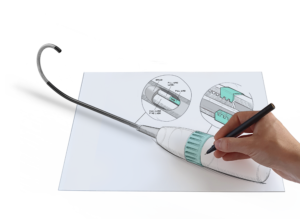Prototyping is not the first step, but fundamentally it is one of the most critical steps in the early lifecycle of your new product. If “a picture is worth a thousand words”, then a prototype is worth a thousand pictures. Taking the outputs of your concept development and giving it a physical form is enlightening, informative, and crucial in gaining a deep understanding of your device.
The objective of prototyping is to take a concept from paper, to a design, to a working form, and then to challenge that prototype.
The designer can then test the device’s functionality, explore its features, and accumulate feedback from its target users – the net result is that the designer learns.

Fail Early, Fail Often
Prototyping should be part of your lean/agile product development process. “Fail early, fail often” emphasises how prototyping is an iterative process and is grounded on the much-accepted assumption that you learn more in ‘failure’. The idea is that if it is possible to learn from failure then the sooner the failure occurs, the sooner the learning begins.
From our perspective at ICS, even if a prototype meets initial functionality criteria, we will challenge to failure so as to understand and characterise the capabilities of the design – do not waste an opportunity to learn from the prototype.
We understand your product development lifecycles and the competitive landscape we all exist in. We take the “fail early, fail often” axiom and apply our own twist – “fail fast, fail often” ensuring Rapid Prototyping is indeed rapid and your development cycle is quick.
Prototyping – An Iterative Process
Prototyping is iterative; in the earlier iterations we focus on key functionality and device features which will define the product’s clinical success. As we iterate, we learn and as we learn we develop. The accumulated learnings help build confidence in the design and the development pathway we are on. As we iterate further, we customise the design towards the final specification, to a product that is close to final form, fit and function.
This allows fast, economical, efficient, and effective proof of concept prototyping in the early days. And as confidence is built it allows greater customisation and investment in development towards the final design specification.

Always Have a Purpose
When we prototype, we look to prototype with a purpose! If we intend to prototype a shaft with functionality and features, we will challenge and test those functions and features, for example:
- Steering catheter with articulation of Xo angle over a Y radius.
- Shaft flexibility comparable common market predicate – side by side testing or 3-point bend test profile along length.
- Your KOL feedback on the prototype.
To see this process applied in the real world, read our blog about how we helped this customer to develop their high-performance valve delivery sheath for clinical trials.
With years of accumulated experience our engineering team at ICS Medical Devices is well positioned to address your catheter prototyping and development needs. Our experience has been accumulated over many years and a wide a variety of projects.
If you need design or prototyping support, or if you would just like some advice on how to approach a project, reach out to us today to speak directly to one of our engineers – info@icsmedical.com